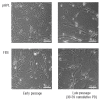Replicative senescence-associated gene expression changes in mesenchymal stromal cells are similar under different culture conditions
- PMID: 20053868
- PMCID: PMC2878782
- DOI: 10.3324/haematol.2009.011692
Replicative senescence-associated gene expression changes in mesenchymal stromal cells are similar under different culture conditions
Abstract
Background: Research on mesenchymal stromal cells has created high expectations for a variety of therapeutic applications. Extensive propagation to yield enough mesenchymal stromal cells for therapy may result in replicative senescence and thus hamper long-term functionality in vivo. Highly variable proliferation rates of mesenchymal stromal cells in the course of long-term expansions under varying culture conditions may already indicate different propensity for cellular senescence. We hypothesized that senescence-associated regulated genes differ in mesenchymal stromal cells propagated under different culture conditions.
Design and methods: Human bone marrow-derived mesenchymal stromal cells were cultured either by serial passaging or by a two-step protocol in three different growth conditions. Culture media were supplemented with either fetal bovine serum in varying concentrations or pooled human platelet lysate.
Results: All mesenchymal stromal cell preparations revealed significant gene expression changes upon long-term culture. Especially genes involved in cell differentiation, apoptosis and cell death were up-regulated, whereas genes involved in mitosis and proliferation were down-regulated. Furthermore, overlapping senescence-associated gene expression changes were found in all mesenchymal stromal cell preparations.
Conclusions: Long-term cell growth induced similar gene expression changes in mesenchymal stromal cells independently of isolation and expansion conditions. In advance of therapeutic application, this panel of genes might offer a feasible approach to assessing mesenchymal stromal cell quality with regard to the state of replicative senescence.
Figures





Similar articles
-
Methods and Strategies for Procurement, Isolation, Characterization, and Assessment of Senescence of Human Mesenchymal Stem Cells from Adipose Tissue.Methods Mol Biol. 2019;2045:37-92. doi: 10.1007/7651_2018_174. Methods Mol Biol. 2019. PMID: 30838605
-
Regulation of multilineage gene expression and apoptosis during in vitro expansion of human bone marrow stromal cells with different cell culture media.Cells Tissues Organs. 2010;192(4):211-20. doi: 10.1159/000313417. Epub 2010 Apr 20. Cells Tissues Organs. 2010. PMID: 20407225
-
Effect of serum choice on replicative senescence in mesenchymal stromal cells.Cytotherapy. 2015 Jul;17(7):874-84. doi: 10.1016/j.jcyt.2015.02.012. Epub 2015 Mar 19. Cytotherapy. 2015. PMID: 25800776
-
Ex vivo expansion of mesenchymal stromal cells.Best Pract Res Clin Haematol. 2011 Mar;24(1):73-81. doi: 10.1016/j.beha.2010.11.002. Epub 2011 Feb 23. Best Pract Res Clin Haematol. 2011. PMID: 21396595 Review.
-
From bone marrow to therapeutic applications: different behaviour and genetic/epigenetic stability during mesenchymal stem cell expansion in autologous and foetal bovine sera?Int J Dev Biol. 2008;52(8):1023-32. doi: 10.1387/ijdb.082725gt. Int J Dev Biol. 2008. PMID: 18956335 Review.
Cited by
-
Comparative Analysis of Human Umbilical Cord Blood-Derived Mesenchymal Stem Cells between Preeclampsia and Normal Pregnant Women.Stem Cells Int. 2020 Jun 8;2020:8403192. doi: 10.1155/2020/8403192. eCollection 2020. Stem Cells Int. 2020. PMID: 32587622 Free PMC article.
-
Nanog reverses the effects of organismal aging on mesenchymal stem cell proliferation and myogenic differentiation potential.Stem Cells. 2012 Dec;30(12):2746-59. doi: 10.1002/stem.1223. Stem Cells. 2012. PMID: 22949105 Free PMC article.
-
Specific age-associated DNA methylation changes in human dermal fibroblasts.PLoS One. 2011 Feb 8;6(2):e16679. doi: 10.1371/journal.pone.0016679. PLoS One. 2011. PMID: 21347436 Free PMC article.
-
Mesenchymal stem/stromal cells: a new ''cells as drugs'' paradigm. Efficacy and critical aspects in cell therapy.Curr Pharm Des. 2013;19(13):2459-73. doi: 10.2174/1381612811319130015. Curr Pharm Des. 2013. PMID: 23278600 Free PMC article. Review.
-
Impact of humanised isolation and culture conditions on stemness and osteogenic potential of bone marrow derived mesenchymal stromal cells.Sci Rep. 2019 Nov 5;9(1):16031. doi: 10.1038/s41598-019-52442-9. Sci Rep. 2019. PMID: 31690774 Free PMC article.
References
-
- Horwitz EM, Le BK, Dominici M, Mueller I, Slaper-Cortenbach I, Marini FC, et al. Clarification of the nomenclature for MSC: The International Society for Cellular Therapy position statement. Cytotherapy. 2005;7(5):393–5. - PubMed
-
- Stamm C, Liebold A, Steinhoff G, Strunk D. Stem cell therapy for ischemic heart disease: beginning or end of the road? Cell Transplant. 2006;15 (Suppl 1):S47–S56. - PubMed
-
- Horwitz EM, Prockop DJ, Fitzpatrick LA, Koo WW, Gordon PL, Neel M, et al. Transplantability and therapeutic effects of bone marrow-derived mesenchymal cells in children with osteogenesis imperfecta. Nat Med. 1999;5(3):309–13. - PubMed
-
- Le Blanc K, Frassoni F, Ball L, Locatelli F, Roelofs H, Lewis I, et al. Mesenchymal stem cells for treatment of steroid-resistant, severe, acute graft-versus-host disease: a phase II study. Lancet. 2008;371(9624):1579–86. - PubMed
-
- Wagner W, Ho AD. Mesenchymal stem cell preparations–comparing apples and oranges. Stem Cell Rev. 2007;3(4):239–48. - PubMed
Publication types
MeSH terms
LinkOut - more resources
Full Text Sources
Other Literature Sources

